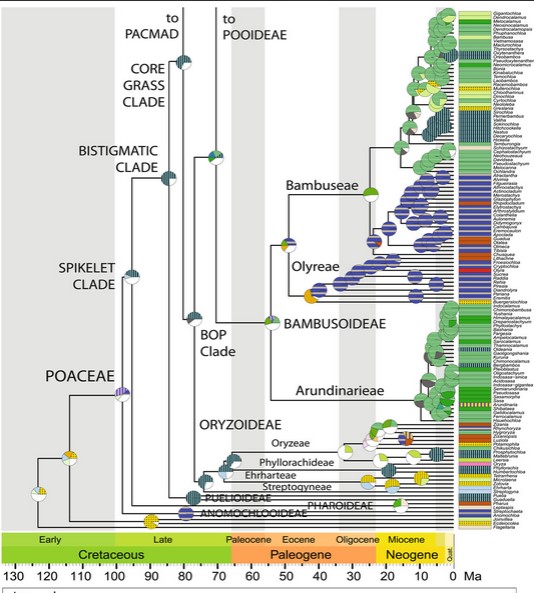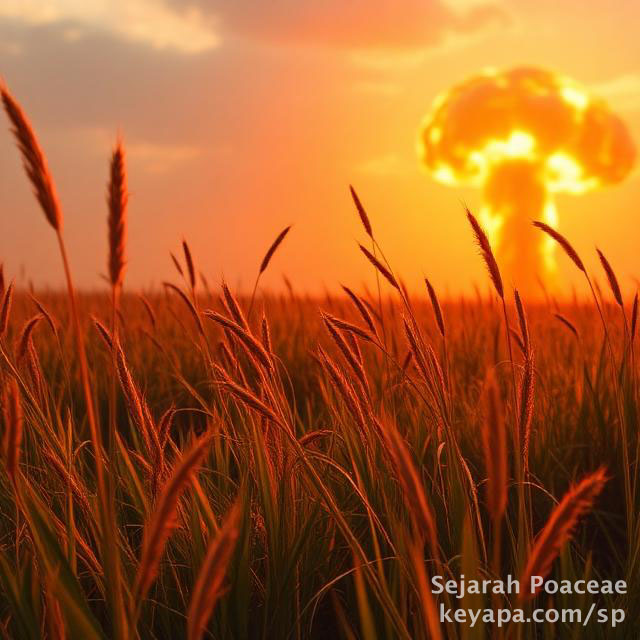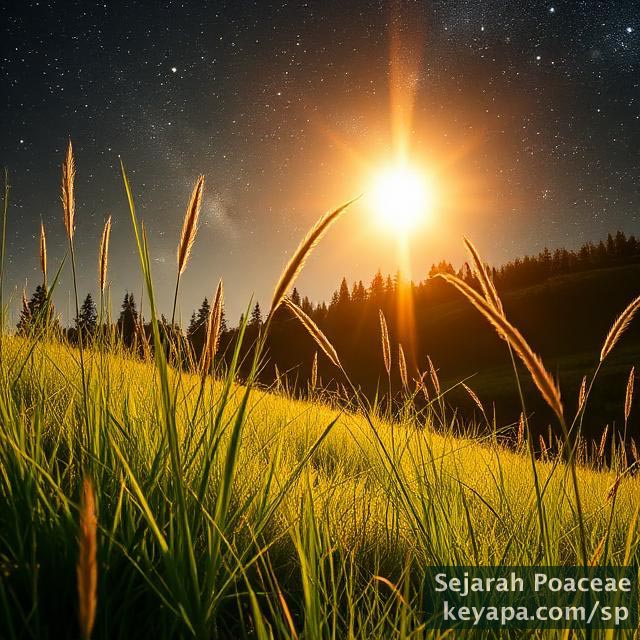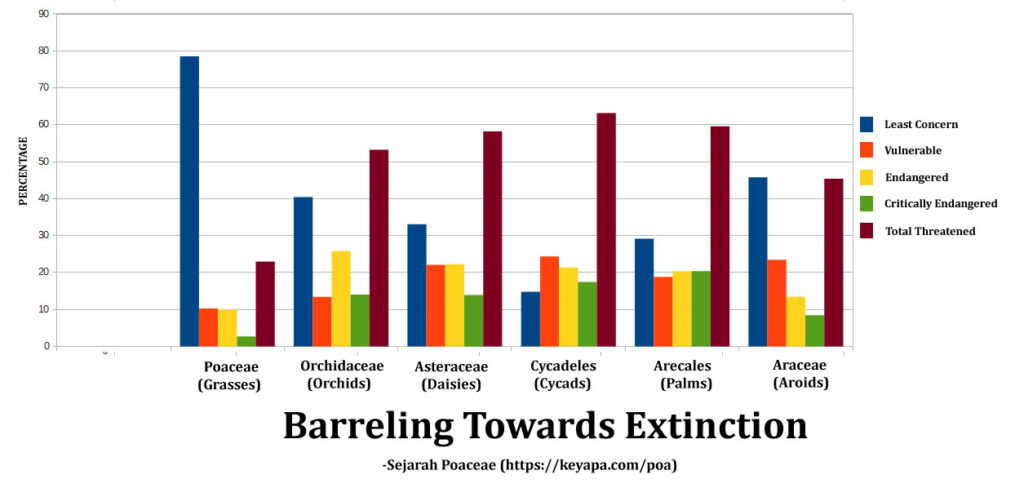The Poaceae have existed on earth for about a hundred million years.
In phylogeny, the stem age of a clade refers to the time when a group first splits from its sister lineage, and thus is considered the origin point of that group. In the case of grasses, one paper posits that this would have been around 114 million years ago (114 Ma). The crown age of a group is defined as the time when the most recent common ancestor of the entire extant members of the group lived, and thus the time when extant species started diversifying. This was calculated to be around 98.5 Ma for the grasses (Gallaher et al, 2022).

The difference between the two numbers has been called the phylogenetic fuse, and this represents the (potentially) many millions of years it took before the ancestors of the clade began to rapidly diversify. Interestingly, a recent study showed that most angiosperm families have substantial time lags (mean 367-56 million years), and that the five most species diverse families (which include the Poaceae) have notably short fuses (Ramírez-Barahona et al, 2020).
Given that the family has already managed to survive for more than 100 million years, would it be safe to say that its survival for another 100 million years is assured? Would a disastrous worldwide nuclear exchange cause an extinction event for the family? Or perhaps even another asteroid hit like the one that happened 65 Ma and caused the rise of angiosperms and the slow decline of other plant groups (and coincidentally, also resulted in the extinction of non-avian dinosaurs)?
Although the family is extremely widespread (in fact, it is one of only two flowering plant families that has a member native to Antartica), and occupies an amazingly large range of habitats, it was interesting to ponder whether there are some data points that we can use to bolster the argument that the Poaceae has a favorable chance of celebrating a happy 200 millionth birthday.

The radiation after a worldwide nuclear war would probably not be the one lethal factor. Plants on the whole seem to be more resistant to ionizing radiations, and studies done in Chernobyl for example, shows vegetation (grasses and trees) increasing over time without regard to the level of radiation measured (Santos et al, 2019). Possible mechanisms for this ability to thrive in the low level radioactivity environment seemed to involve alterations to plant metabolism, including activation of proteins involved in heavy metal stress and carbon metabolism (Klubicová et al, 2012).

Even another global disaster similar to the Cretaceous-Paleogene mass extinction event (K-Pg) where up to 75% of all animal species went extinct would probably fail to ensure the extinction of the Poaceae. A recent phylogenetic study of tens of thousands of extant angiosperm species showed that extinction rates for this group remained relatively constant throughout geological time, and that there was no mass extinction of flowering plants during the K-pg boundary. This study is bolstered by fossil evidence, which indicate that this dinosaur killing event had only minor impacts on the extinction of angiosperm lineages (Thompson and Ramírez-Barahona, 2023).

Finally, there has been large concern over a sixth mass extinction, which is being caused by human activity. Although many grass species (and especially endemic ones limited to single sites) are definitely being affected, the Red List of the International Union for Conservation of Nature (IUCN) shows some hope for the family. About 20% of the Poaceae species in the database that have adequate information are labeled “threatened”, but this seemingly alarming number is significantly lower than the percentage for other major plants families. Models that were used to predict extinction risks also showed the Poaceae as one of the less threatened families (Bachman et al, 2024).
In the end, the data and studies above seem to indicate that there is a good chance that some future members of the family Poaceae might indeed still be around a 100 million years from now. If there are still humans around at that time (a highly improbable event, but one can hope), perhaps they will give a toast to the longevity of one of the most successful plant lineages of all time.
Literature Cited and References
Bachman, S.P., Brown, M.J.M., Leão, T.C.C., Nic Lughadha, E. and Walker, B.E. (2024), Extinction risk predictions for the world’s flowering plants to support their conservation. New Phytol, 242: 797-808. https://doi.org/10.1111/nph.19592
Gallaher, T. J., Peterson, P. M., Soreng, R. J., Zuloaga, F. O., Clark, L. G., Kellogg, E. A., Teisher, J. K., & Li, D.-Z. (2022). Grasses through space and time: An overview of the biogeographical and macroevolutionary history of Poaceae. Journal of Systematics and Evolution, 60(3), 522–569. https://doi.org/10.1111/jse.12857.
Klubicová K, Danchenko M, Skultety L, Berezhna VV, Uvackova L, Rashydov NM, Hajduch M. (2012). Soybeans grown in the Chernobyl area produce fertile seeds that have increased heavy metal resistance and modified carbon metabolism. PLoS One. 2012;7(10):e48169. doi: 10.1371/journal.pone.0048169. Epub 2012 Oct 26. PMID: 23110204; PMCID: PMC3482187.
Manchester SR, Walter S Judd, Julian E Correa-Narvaez (2024). Vegetative and reproductive morphology of Othniophyton elongatum (MacGinitie) gen. et comb. nov., an extinct angiosperm of possible caryophyllalean affinity from the Eocene of Colorado and Utah, USA, Annals of Botany, 2024;, mcae196, https://doi.org/10.1093/aob/mcae196
Ramírez-Barahona, S., Sauquet, H. & Magallón, S. (2020). The delayed and geographically heterogeneous diversification of flowering plant families. Nat Ecol Evol 4, 1232–1238 (2020). https://doi.org/10.1038/s41559-020-1241-3
Santos PP, N. Sillero, Z. Boratynski, and A. C. Teodoro (2019). “Landscape changes at Chernobyl”, Proc. SPIE 11149, Remote Sensing for Agriculture, Ecosystems, and Hydrology XXI, 111491X (21 October 2019); https://doi.org/10.1117/12.2532564
Thompson JB, Ramírez-Barahona S. (2023). No phylogenetic evidence for angiosperm mass extinction at the Cretaceous-Palaeogene (K-Pg) boundary. Biol Lett. 2023 Sep;19(9):20230314. doi: 10.1098/rsbl.2023.0314. Epub 2023 Sep 13. PMID: 37700701; PMCID: PMC10498348.
Wiens JJ, Saban KE. (2025). Recent extinctions of plant and animal genera are rare, localized, and decelerated. PLoS Biol. 2025 Sep 4;23(9):e3003356. doi: 10.1371/journal.pbio.3003356. PMID: 40906755; PMCID: PMC12410804.

Leave a Reply